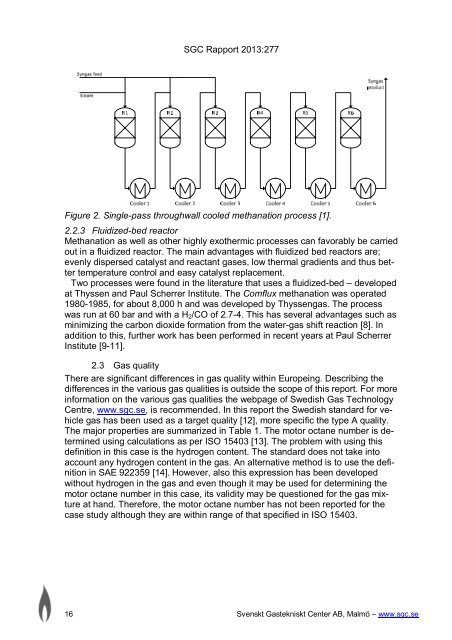Carbon dioxide removal in indirect gasification - SGC
Carbon dioxide removal in indirect gasification - SGC
Carbon dioxide removal in indirect gasification - SGC
You also want an ePaper? Increase the reach of your titles
YUMPU automatically turns print PDFs into web optimized ePapers that Google loves.
<strong>SGC</strong> Rapport 2013:277<br />
Figure 2. S<strong>in</strong>gle-pass throughwall cooled methanation process [1].<br />
2.2.3 Fluidized-bed reactor<br />
Methanation as well as other highly exothermic processes can favorably be carried<br />
out <strong>in</strong> a fluidized reactor. The ma<strong>in</strong> advantages with fluidized bed reactors are;<br />
evenly dispersed catalyst and reactant gases, low thermal gradients and thus better<br />
temperature control and easy catalyst replacement.<br />
Two processes were found <strong>in</strong> the literature that uses a fluidized-bed – developed<br />
at Thyssen and Paul Scherrer Institute. The Comflux methanation was operated<br />
1980-1985, for about 8,000 h and was developed by Thyssengas. The process<br />
was run at 60 bar and with a H2/CO of 2.7-4. This has several advantages such as<br />
m<strong>in</strong>imiz<strong>in</strong>g the carbon <strong>dioxide</strong> formation from the water-gas shift reaction [8]. In<br />
addition to this, further work has been performed <strong>in</strong> recent years at Paul Scherrer<br />
Institute [9-11].<br />
2.3 Gas quality<br />
There are significant differences <strong>in</strong> gas quality with<strong>in</strong> Europe<strong>in</strong>g. Describ<strong>in</strong>g the<br />
differences <strong>in</strong> the various gas qualities is outside the scope of this report. For more<br />
<strong>in</strong>formation on the various gas qualities the webpage of Swedish Gas Technology<br />
Centre, www.sgc.se, is recommended. In this report the Swedish standard for vehicle<br />
gas has been used as a target quality [12], more specific the type A quality.<br />
The major properties are summarized <strong>in</strong> Table 1. The motor octane number is determ<strong>in</strong>ed<br />
us<strong>in</strong>g calculations as per ISO 15403 [13]. The problem with us<strong>in</strong>g this<br />
def<strong>in</strong>ition <strong>in</strong> this case is the hydrogen content. The standard does not take <strong>in</strong>to<br />
account any hydrogen content <strong>in</strong> the gas. An alternative method is to use the def<strong>in</strong>ition<br />
<strong>in</strong> SAE 922359 [14]. However, also this expression has been developed<br />
without hydrogen <strong>in</strong> the gas and even though it may be used for determ<strong>in</strong><strong>in</strong>g the<br />
motor octane number <strong>in</strong> this case, its validity may be questioned for the gas mixture<br />
at hand. Therefore, the motor octane number has not been reported for the<br />
case study although they are with<strong>in</strong> range of that specified <strong>in</strong> ISO 15403.<br />
16 Svenskt Gastekniskt Center AB, Malmö – www.sgc.se

















